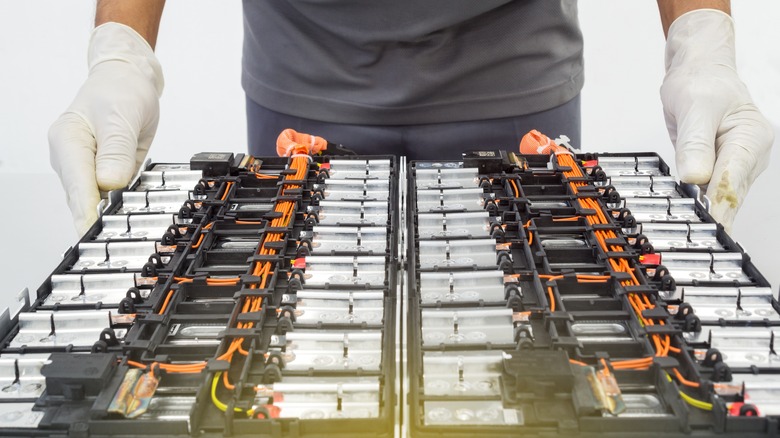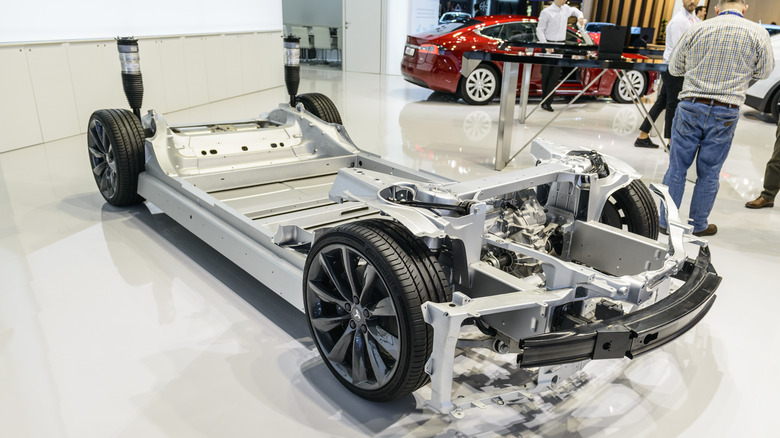The New EV Battery That Could Change The Industry
Electric vehicles have advanced rapidly over the last few years. They're becoming a common sight on the streets, Tesla and Lucid's best efforts are rivaling those of traditional luxury car brands, and high gas prices are making large numbers of Americans think about going electric. But electric car manufacturers aren't resting on their laurels, things may be about to get even better. Several companies, including Tesla and their Chinese rivals BTD, are looking into an innovative battery design that could increase an electric vehicle's performance and range. Batteries are vital to electric vehicles. They're also a point of concern skeptics like to bring up regularly.
Replacing the batteries in something like a Tesla Model X is likely to be a big, expensive job. Luckily, the chances are they won't have to be replaced that often, if at all. EV rental company Tesloop claims that one of its cars has clocked 330,000 miles and that vehicle's batteries have only degraded by 23%. This is in line with Elon Musk's claims that Tesla's batteries should last between 300,000 and 500,000 miles or 1,500 charging cycles. The average vehicle owner puts around 12,000 miles a year on their car. If you were to encounter a vehicle on the second-hand market that had done 300,000 miles — it would probably have more issues than battery degradation. So in the year 2022, EV batteries are good. But can they get even better?
The trouble with batteries
Battery technology has come a long way. but eventually, things hit a point of diminishing returns. When a piece of technology is new and not well understood, discoveries are easy to come by and there are plenty of ways something can be made more efficient. However, as technology matures, researchers start having to put in twice the amount of work in return for a fraction of the progress. Lithium-based batteries, which are used in everything from cell phones to electric vehicles, have been around for a while. If they aren't already at the point of diminishing returns, they may hit it very soon (via Green Tech Media).
If your EV needs more juice and you can't make its batteries more efficient, there is a simple solution. You can simply add more battery cells — but this just leads to more issues. With car design, weight is a major consideration. Batteries are heavy, so adding more would bump up a car's weight significantly. Moving that weight takes more energy, so a chunk of the added battery capacity will disappear immediately. Then there's the effect on the car's handling and components. Heavier objects are also harder to stop, so the brakes will need an upgrade, and there could still be somewhat of a safety issue. Luckily, there is a solution that works, and we could be seeing it on EVs very soon.
Innovative new batteries could change the EV game
Two major advancements are going to make EV batteries of the future far more efficient. The first involves better integrating them with the vehicle's structure, and the second involves replacing inert structural parts of the battery with material that can hold and distribute a charge, and eliminating dead space in those batteries. Plug Life Consulting's Euan McTurk told Wired what his idea of a perfect battery was. He says: "The ultimate battery pack would be one that consists of 100 percent active material. That is, every part of the battery pack stores and releases energy." Current battery assembly practices, which involve placing cells in "modules" then connecting those modules together into "packs" can leave a lot of inefficient empty space. BYD is pioneering a "cell-to-pack" system with its "Blade Cells," which may eliminate that dead space. Cell-to-pack systems, new battery compositions like lithium-ion phosphate, and more efficient use of the vehicle's structure are going to lead to drastic gains in vehicle range.
Currently, EV batteries are usually lining the floor of the vehicle and double stacked in certain areas like behind the rear seats and underneath the center console. This sort of spacing is what gives cars like the Lucid Air their incredible range. However, the Air is an extremely high-end car and can only manage 520 miles. Wide adoption of these new battery principles could lead to more affordable EVs breaking through the 600-mile range barrier.

